There are many systems involved in the restaurant business and many of them are expensive, wasteful, unsustainable and antiquated: for staff, for ingredients, for customers, for owners. Change was already beginning to sweep across this high-turnover industry before the pandemic, but now that change is accelerating, in many directions. We invited Berlin chef Alexander Brosin to The Common Table to talk about his journey from dreams of travel in the GDR, via a series of Michelin-starred kitchens, back to the kitchen garden and then on to the Data Kitchen – and why training is everything.
Orlando Lovell: What made you become a chef?
Alexander Brosin: I grew up in Thuringia, in East Germany. In the GDR there was no freedom to travel then, it wasn’t allowed. As a child, I had a beautiful old book from the 1920s, still with old German writing and black and white photos. It was called A Journey Around the World. I used to read it and dream of faraway places — of being somewhere else. So I planned to join the merchant navy but then I thought: “What will you do there?” So it turned into: “Okay, first you’re going to learn to be a cook, then you’re going to get on a ship, and then you’re going to see the world.”
Sophie Lovell: And were you allowed to do what you wanted to do?
That was the plan. But it turned out differently – as plans do. My family also applied to leave the country in 1982. In May 1989, half a year before the Wall came down, their application was suddenly approved. We were told: “okay, you can leave – but right now”. So, of course, we packed a few belongings and left. In other words, I started my training in the GDR in 1987 but then, with a few detours, ended up taking a classic career path as a chef in the West. As a chef, you travel quite a lot, changing places every two or three years. If you feel comfortable, you might stay in the same place for four years or so. But if you are always looking for new goals, it is relatively easy to get a new position in this business.
I worked in London at the Savoy, when Anton Edelmann was maître chef, then in Berlin at the Adlon Hotel, at the Quadriga in Brandenburger Hof for chef Sauli Kemppainen, and at the Margaux, with Michael Hoffmann.
SL: So it’s pretty traditional for young chefs to travel and collect a range of experiences with different chefs and kitchens – like the traditional journeyman years for carpenters in Germany?
Yes, exactly. Amongst other places, I worked in London at the Savoy, when Anton Edelmann was maître chef, then in Berlin at the Adlon Hotel, at the Quadriga in Brandenburger Hof for chef Sauli Kemppainen, and at the Margaux, with Michael Hoffmann. After that, I went to a nice hotel by a lake in Köpenick [in southeast Berlin] that wanted to switch from conventional to organic and took over the kitchen part for them.
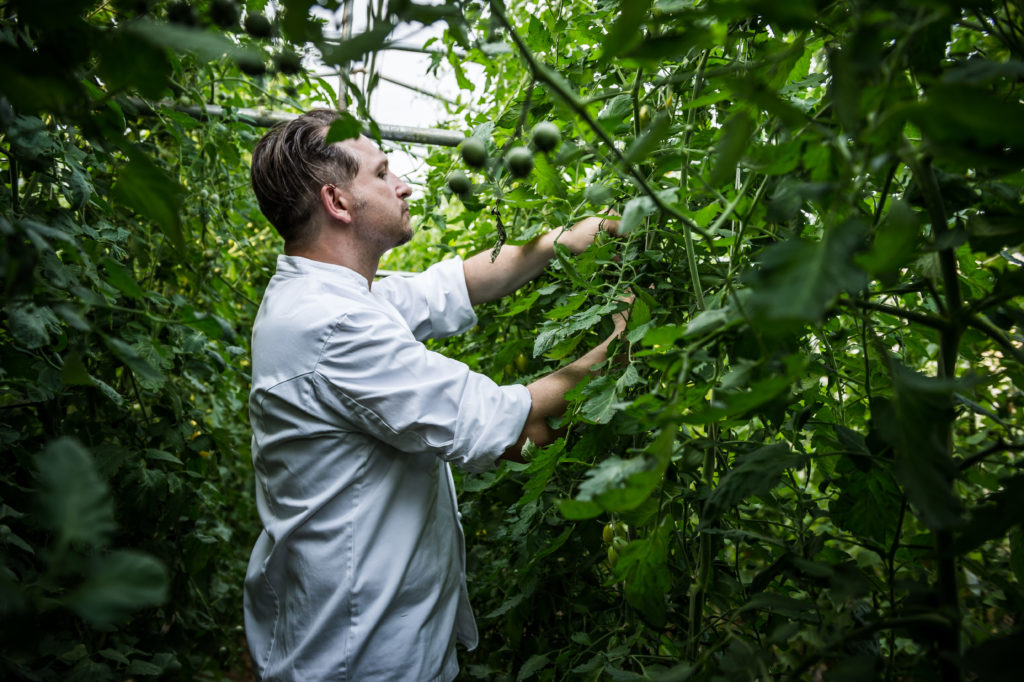
SL: Michael Hoffmann is famous as Berlin’s Michelin-starred top chef who first abandoned traditional French Haute Cuisine for his own cooking with seasonal and regional ingredients and then closed his restaurant Margaux entirely to dedicate himself to his garden instead. He must have had quite an influence on you…
Yes. Michael Hoffmann later offered me the job of doing “the garden” out in Krielow in Werder. So I became his gardener and sous chef – his right-hand man, which was exciting. I ended up working for him for six years, on and off and I learned a lot. There was something very caring about his affinity to produce and the way he handled it. Even back then, ten years ago, the issue of sustainability was very important to him. We were always thinking about how to process a product entirely. This included drying peel, making herb vinegars and herb salts, fermenting, bottling and making various kinds of vegetable stock through to cooking entire vegetables. The planning, sowing and harvesting were all done by the team, with a great deal of individual, personal input. It really bonded us together. The thoroughness and the effort that was put into it still gets me – even today.
The planning, sowing and harvesting were all done by the team, with a great deal of individual, personal input.
OL: That was quite a big system change wasn’t it? From the accepted traditional “high art”, luxury end of cooking to working with local ingredients from your own kitchen garden. Could you explain Michael Hoffmann’s reason for doing so and why it struck such a chord with you? What was wrong with the system behind Haute Cuisine?
I think I just answered that in a way. The decision-makers often lack foresight; lack vision. They still tend to rely on long-established or luxury products – the more exotic they are, the more interesting. It puts people working in the industry under a lot of pressure. But this is also a societal problem. We all want to jump higher than the rest, be faster and better than the others. Most of us are too focused on the competition, instead of perhaps thinking about how we can do things better together… But nevertheless, there are also many, very good, positive examples.
SL: You then went on to become the chef at Markthalle Neun’s Kantine in Berlin-Kreuzberg. What did you take with you from your experience and practice with Michael Hoffmann?
At the Kantine, we also used our own vegetables from the garden. There, too, I was both chef and gardener. That only works with a team that has your back, because, of course, I can’t be on-site when I’m in the garden. But it worked well. Then I started at the Data Kitchen in 2016.
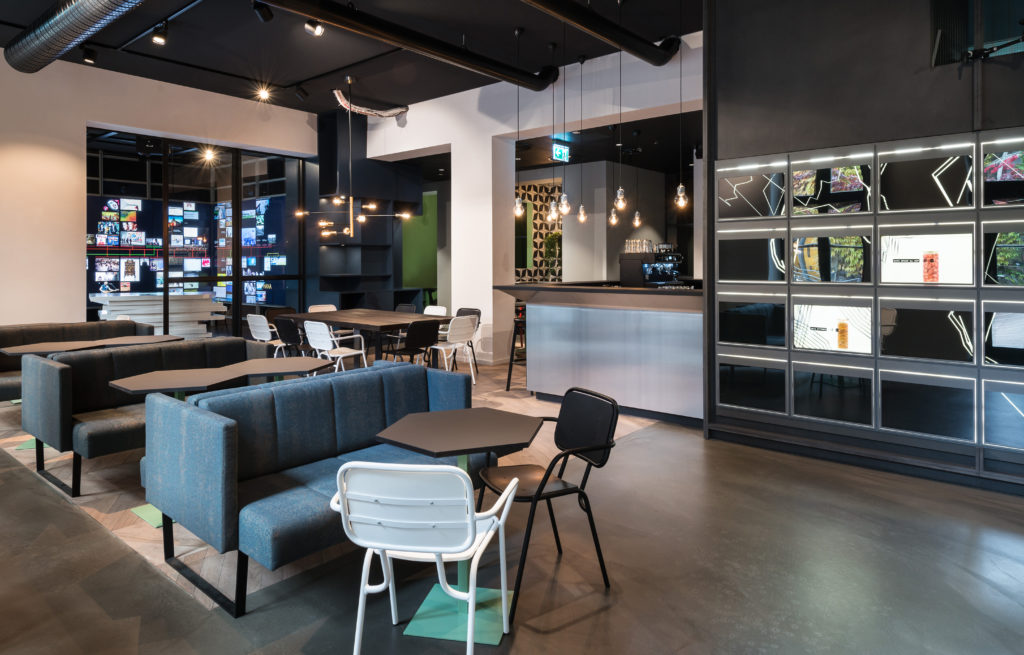
OL: The Data Kitchen was the third restaurant in the Cookies Cream and Crackers alliance founded by the legendary club owner and gastro-entrepreneur known as Cookie. Through an innovative collaboration with the software company SAP, a whole new gastro experience was created in Berlin-Mitte, next to the SAP headquarters. How would you describe Data Kitchen?
It’s a digital restaurant designed for people who work in the area and don’t have much time for lunch. Usually, you only have half an hour to eat lunch when you are working in an office. Early in the morning, you can use your smartphone to pre-order your meal in the Data Kitchen. You set a certain time, for example, 12 o’clock, and walk into the Data Kitchen, open the box with your name on the display using your smartphone, take your food out, go sit down and enjoy your meal. When you order ahead, you’ve already prepaid with Paypal or credit card so when you’ve eaten, you can drop everything and leave. Another good thing about this concept is that the role of the “waiter” became more that of a host. There was more time to really take care of the guest – if the guest wants it.
OL: So they asked the most analogue of chefs, now more used to wellington boots and gardens, to run this experimental technical interface restaurant?
Yes! In fact, we agreed on it relatively quickly. In the beginning, I wasn’t aware of the technical dimensions. What I found very exciting was that I was involved in the planning from the very beginning: imagining bit-by-bit how the restaurant would look and how it would work with the app. Were there any technical problems? How would the kitchen cope with the interface? I think we imagined far worse things than anything that really happened. Actually, nothing bad ever did happen – except for a power failure once. That’s why it’s important that the cooking part is analogue. The final hybrid of analogue mechanisms and digitalisation wasn’t a bad mix.
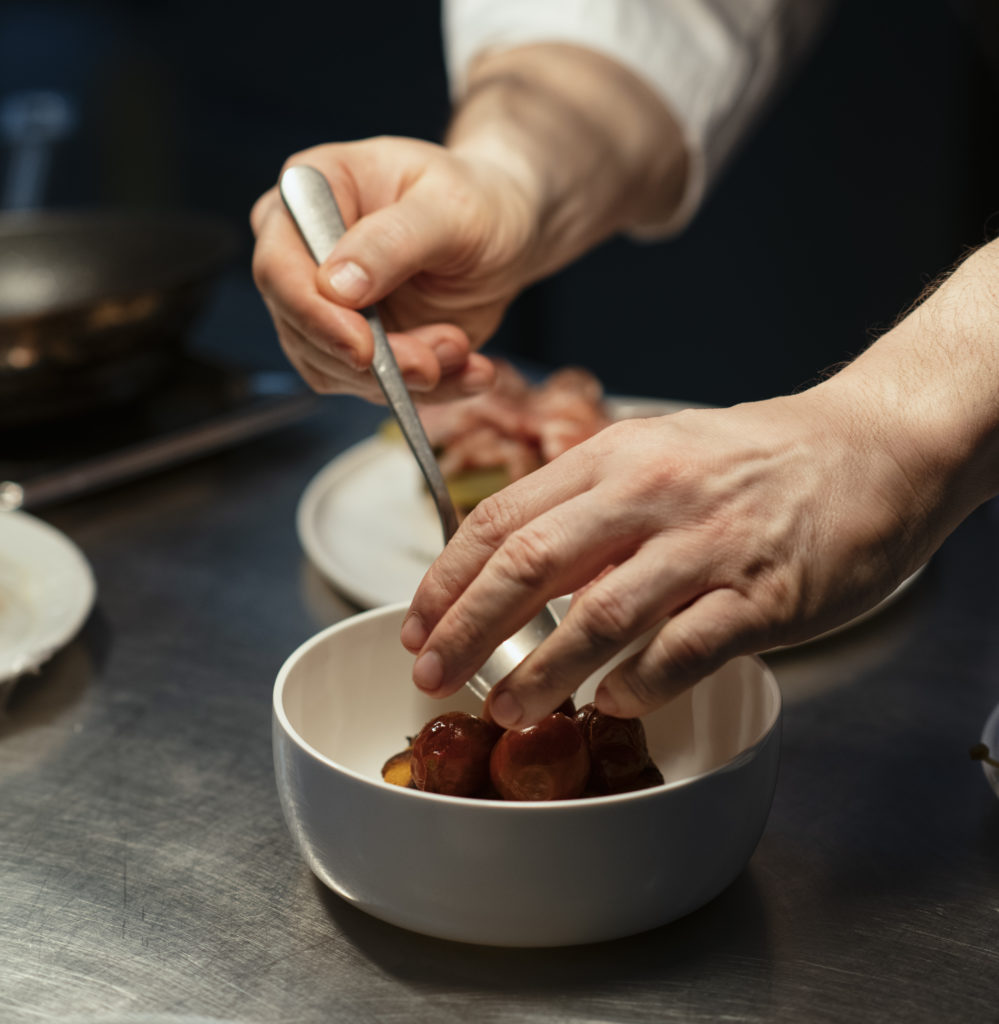
OL: After a year of pandemic restrictions, the Data Kitchen is no more as of January 2021 – or at least not with you and Cookie on board. What do you take away from your experience there?
Basically, it was a very forward-looking project, one that should be replicated. What the pandemic has taught us, for example, is that we should have as little contact as possible. This concept, where you order via your smartphone, made this possible. I think it’s definitely very important that classical gastronomy, which still thinks very conservatively, should be more open and rethink the ordering and payment process. But – as we are experiencing at the moment – gastronomy without any interaction between host and guest is really sad.
OL: Usually, several people walk into a restaurant at lunchtime, all get a menu, choose something, order, and then you cook. In the Data Kitchen, you cooked before the guests arrived at a fixed pick-up time. Was it difficult for you, as a chef, to turn this process around?
No, not really. That was also a good thing about the concept – actually seeing how the time slots filled up. Knowing, for example, that it will be full that day at noon. It’s different from a restaurant where the guests just come in: where you suddenly see that a dish is going well and have to produce more, fast, otherwise you won’t have enough of it. With the Data Kitchen model, you could work more economically and adjust your system accordingly.
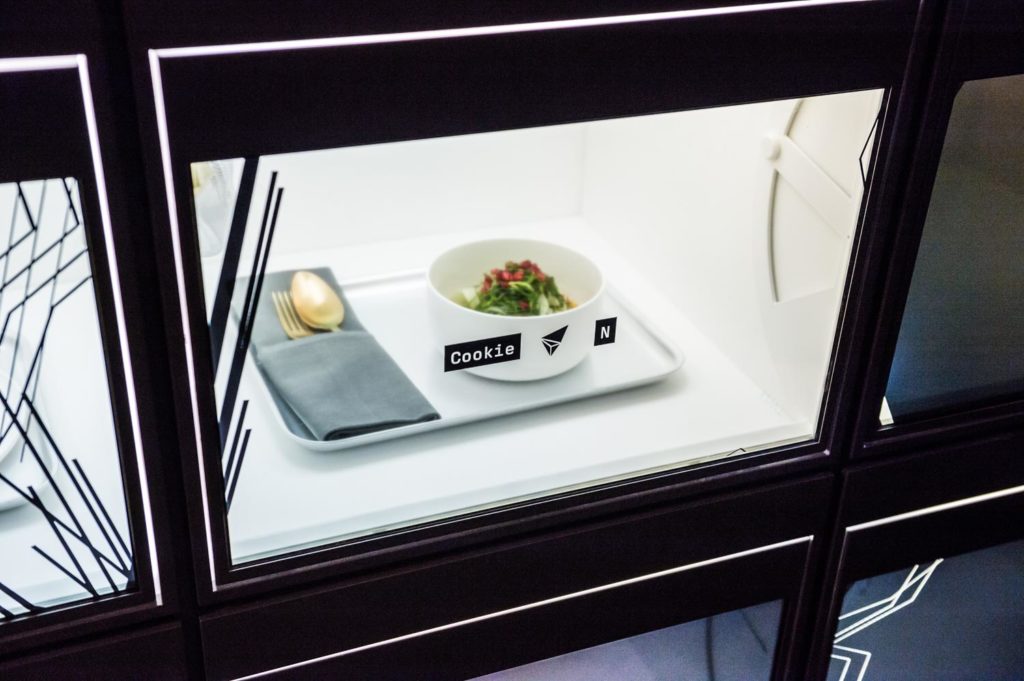
OL: What aspects make sense to digitalise in a kitchen and what don’t? How much in the kitchen and how much in the service area?
Well, it was very cleverly solved the way it was and it was good that most of the digitisation part was placed outside the kitchen. We had a ticketing screen in the kitchen, which was not quite as stressful as the paper ticket system. Another thing that would make sense, but unfortunately wasn’t implemented there, is to digitalise the merchandise management system. Scanning what comes in and goes out of the cold store, for example. Digitising the cooking process makes little sense – even though people are already experimenting in this area.
OL: I know that you also keep contact with your suppliers very analogue and you talk to them regularly on the phone.
We already had a form of digitalisation in there: there are new apps now that bring all the suppliers together. We ordered via a tablet a few times and it’s fine, but I need real contact with my suppliers. I also like to go out into the garden and ask the gardener “What did you grow this year? What does it look like?” Then ideas pop into my head as well. A small supplier, like our gardener, for example, can also respond to our needs with what he plants and harvests. It’s different from sitting with an iPad and thinking “What do I need tomorrow?”
OL: As a chef, how much do you know about where the food comes from? How much do you trust your suppliers?
It’s always been incredibly important to me to be so close to my suppliers that I can see exactly how they work. Sure, sometimes you can’t avoid having a bigger supplier in there who can cover the other things, but for me, it’s super important to have small suppliers and to have really good and close contact with them.
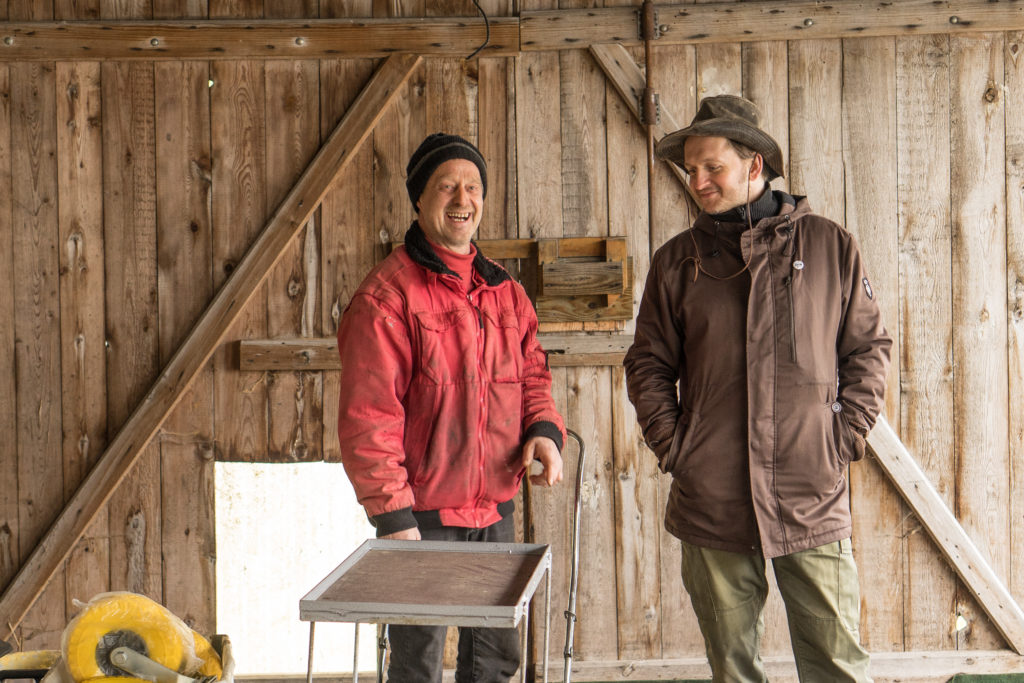
SL: Do you think there is a division between chefs who are increasingly “local”, like yourself and others who are more part of the huge global supply chain machine?
I don’t think there is a division – maybe it’s more of a branching off. It is noticeable that the smaller restaurants with less capacity tend to go in this direction, that they are the ones who take time to think about what is important. Sustainability can be a big factor for them too. And then there are of course those who only go for mass. The ones who only buy from the big suppliers, who are not interested in where the product is from and usually not very interested in what the product is like either. There is no rule though, there are also bigger restaurants that care about the quality and origin of their products.

O: Is this small, local solution the solution? If so, how do we transpose this practice to mass-scale catering? In large canteens, for example?
The local solution at a small scale is already very good here in Germany, I would say. But it’s not like there are no solutions for canteen kitchens working at a scale of 200 or 300 guests a day too. It’s up to you as a chef. Sure, you can buy from big organic suppliers, to feel good ethically, but you also have to tackle the issue. You can’t just sit behind your desk and make holiday plans on the computer or write duty rosters. You have to make sure that you train your team, that you awaken passion – for good products as well.
You can’t just sit behind your desk and make holiday plans on the computer or write duty rosters.
OL: Can you give us a good example?
A: Have you heard of the Kantine Zukunft Berlin? The Canteen ‘Future’ Berlin? It’s a local, government-funded project that started in 2019. They train canteen chefs to use more regional and seasonal products and create more healthy and appealing dishes. For example, they published a recipe booklet at the beginning of the year for it called Für Viele (For Many), and asked various Berlin chefs, myself included, to each write a recipe for it. I really liked the solidarity involved in the idea of helping and inspiring other cooks. These are all recipes that can be easily implemented in any canteen. But, as I said, the interest must come from above or from the kitchen staff not to just stick with “this is how we’ve always done it”.
SL: Gastronomy seems to be experiencing a change in work ideology as well. Would you agree?
I’ve lived in Berlin for 17 years now and have noticed over the last five to ten years that more and more attention is being paid to the work-life balance, which was never the case before. As a cook, I was never very interested in it. You just went to the next place you thought would get you ahead. There was this two to three-year rhythm to it. Now the business owners take more care of the chefs, and also the staff. It wasn’t the case before. It was also pretty perfect at Data Kitchen, working from 8 am to 5 pm with the occasional extra event. Then you would have a full day, but we chefs are used to that anyway, 12-14 hour days should be okay.
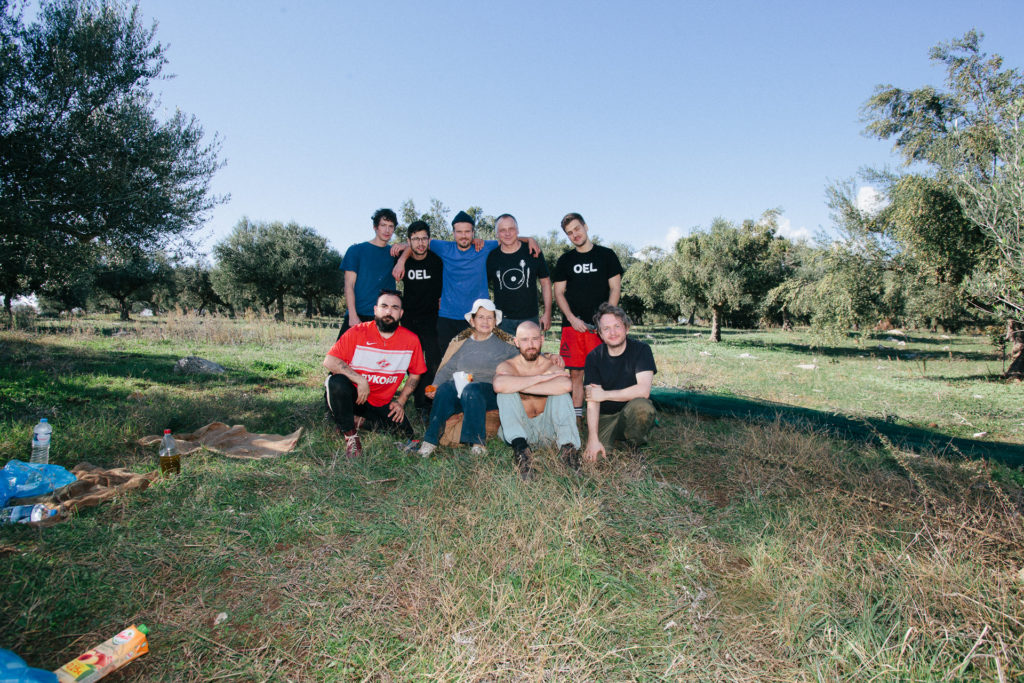
SL: But should a workday that long really be okay?
Occasionally it should be okay. I can remember times when I regularly worked 14-16 hours a day. Yes, I know. Zombie.
SL: If you look at that in terms of sustainability as a job, it doesn’t sound very sustainable either. I think that people are now looking at sustainability in all sorts of areas. I have, for example, never heard so much discussion about the four-day-week and universal basic income as I have in the past few months...
OL: True. The way you were talking about the Kantine, makes me assume that the educational moment is the right moment to change or define approaches – such as how a chef thinks about produce. With that in mind, how does one learn to be a chef? Is the cliché, that you start as a dishwasher and work your way up, that common? Is a chef’s “university” the establishments you work in, changing every two to three years as you mentioned, or is there a step before that where you get basic training?
The dishwasher route? Yes, there’s a lot of that still, especially in Berlin. As an international city, you have a lot of people entering the industry laterally. Basically, in Germany, you have the dual education system, [which allows you to simultaneously do vocational studies and apprenticeships for certain occupations]. If you want to become a chef, you have to do an apprenticeship as a chef. Then you look for a restaurant, preferably one that suits you, and start your training there. Then you go to the next place, and the next place… and try to develop your own style, taking what you like from all the restaurants along the way. So the teaching that the kitchen chefs do is very important. Training the staff, bringing them further and letting them develop is what brings gastronomy forward as a whole.
Training the staff, bringing them further and letting them develop is what brings gastronomy forward as a whole.
O: Does the guest also train the chef in some ways? Society is also evolving and people are more and more interested in wanting to know where their food comes from and what is in it – even in restaurants.
Constructive feedback from guests is important for every chef. It’s great if they don’t just write a Google review, but try to engage in a conversation. It takes us further as well. On the flip side, although you don’t want to go around pointing fingers and telling guests “don’t eat so much red meat” or “vegetables are better”, chefs have a kind of teaching mission here as well, at least as I see it. The question is how you do it. Food is always political. That’s why it’s important to take the guest with you on a journey.
Interview by Sophie & Orlando Lovell






